Milwaukee Country Club
Wisconsin, United States of America

Set over gorgeous property, Milwaukee Country Club is a standard-bearer for the best virtues that parkland golf has to offer.
The idea of a country club – literally a club in the country – has great merit. Nowhere is the game better enjoyed than away from the crush of the masses. Golf courses and clubs are land intensive and the land cost in the country helps make the proposition feasible. Searching for the best property is time well spent as the better the property, the better the course will likely be. Milwaukee Country Club, which occupies one of the top dozen or so properties of any country club in the United States, is a prime example of this concept.
Like many clubs of historic importance, Milwaukee Country Club’s origins were elsewhere from its present location. According to its well produced centennial club history book entitled A Sense of Tradition by John Gurda, the original course comprised of play in a pasture, before evolving to nine holes in 1898. Golf became understood as it was played with vital lessons learned, including the drawbacks of building a course on flattish land over heavy clay soil. Standing water became a dreaded nuisance, precluding any hopes of fast and firm conditions suitable for golf, especially with the gutta percha ball.
In 1909, the club’s prospects for possessing good golf brightened considerably when members found today’s site within ten miles north of the downtown business district. The soil was sandy loam in spots with more than half of the 108 acres located high with nice movement over a river valley.
Though the golf architecture work being done in the 1910’s was superior to that of the 1900’s, it was still a far cry short of what would be accomplished during the height of the Golden Age of architecture in the 1920’s. The head golf professional at Milwaukee, Alex Robertson, oversaw the construction of eighteen holes that included more of his ideas than those of Tom Benedelow, who had been called up from Chicago. Parallel holes abounded and Robertson’s eighteen holes felt cramped as they were crammed into the a section of today’s property that only features ten holes.
Thus in 1924, another 77 acres were acquired including the yummy section where today’s fifth through eleventh holes reside and Walter Travis was brought in. One might think this would have been the final answer as Travis was a legend within the sport. While he excelled at building features, Travis’s routing skills betrayed him at Milwaukee and the resulting effort paled against his other architectural achievements. Based in New York, it is unclear how much time Travis spent on property. Whatever the reason, though Travis was the most accomplished architect to work at Milwaukee to date, his course actually existed the briefest period of time.
The crème de le crème of Milwaukee society demanded something better. Golf became ensconced as an important part of life for the well-heeled of the 1920’s Midwest and numerous courses around greater Chicago captured the grandeur of the game far better than Milwaukee Country Club.
A few final pieces to the puzzle came together. First, it was agreed to move the clubhouse somewhat lower and on the edge of the bluff, which opened up the possibility for the high spot of the property to be occupied by Alison’s eighteenth fairway instead of the building. Simultaneously, a triangular plot of 10 acres was acquired north of the Milwaukee River; the very patch of land where today’s twelfth green, thirteenth hole and fourteenth tee now reside. At nearly 200 acres, the club now possessed ample room for a world class course and the prospects must have been enticing to Charles Hugh Alison when he arrived in 1927. High on a bluff would stand a majestic clubhouse, below was a river valley and the opportunity to traverse the eighty yard wide Milwaukee River in several spots. Plus the river lent the soil sandy qualities so favorable for the game of golf.
Give a great architect great land and a great course should ensue. That’s exactly what happened here which should surprise no one familiar with Alison’s glittering resume. According to the late great historian Tom MacWood, “Born in Lancashire, England in 1883, he had been educated at Malvern and Oxford. Better known for athletics than academics, Alison excelled at both cricket and golf. He was the youngest member of the Oxford and Cambridge Golf Society’s team, captained by John Low, which toured America in 1903. Following a short career in cricket and golf journalism, Alison became the secretary of the new Stoke Poges Golf Club in 1907, a Colt design in the London outskirts. It is believed he dabbled in design while serving as secretary, but he didn’t devote himself completely to golf architecture until after WWI – going into partnership with Colt and Alister MacKenzie. Almost immediately he was dispatched to America where he worked throughout the twenties, producing a number of impressive designs.”
Alison first oversaw the completion of the last three holes at Pine Valley Golf Club. His work at Kirtland Country Club in 1921 to the east of Cleveland ranked among the best in the golf rich state of Ohio. His Timber Point on the south shore of Long Island in 1923 drew rave reviews and was considered among the very best in the country at that time. His sterling Seaside nine holes at Sea Island had just opened and counted Bob Jones as its most ardent fan. Alison’s last great work in North America would occur at Milwaukee. After that, the Great Depression sent him to Japan and later the Netherlands where several more world class designs were constructed including Hirono, Kawana and Royal Hague.
Unlike Travis, Alison spent a considerable time on site routing and the result is today’s course with all of his playing corridors still in use. A few of Travis’s corridors were preserved including the 2nd, 15th and 16th which roughly parallel each other as well as the Milwaukee River. The course now became the fresh and exciting venue longed for by the members.
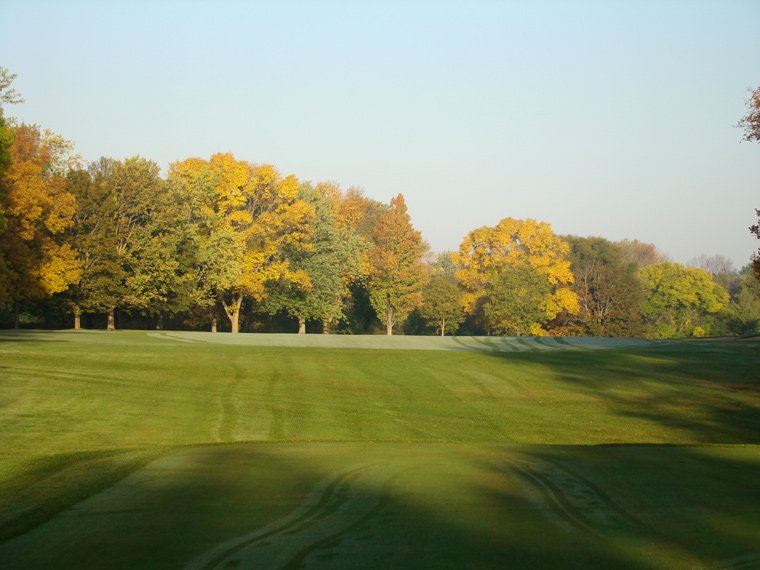
Milwaukee’s specimen trees add to the overall ambiance of the round. Few places provide a more enticing fall game than Milwaukee when its autumnal colors are on full display.
At the heart of the experience is the bucolic setting that the club enjoys to this day. Outside intrusions are at bare minimum. Rather the golfer (and tennis player and paddle ball player and swimmer for that matter) is free to concentrate on the task at hand. While working in the urban cityscape of Milwaukee one can only imagine the pleasure that its members derive by driving north to escape into the pretty Wisconsin landscape. The golf experience alternates between the topographic challenges posed on the front to the glories of playing along the snaking river on the back before climbing out of the river valley for the last two holes. Together the two nines encircle the clubhouse which stands some ninety feet above the holes in the river valley. What more could one possibly ask for?!
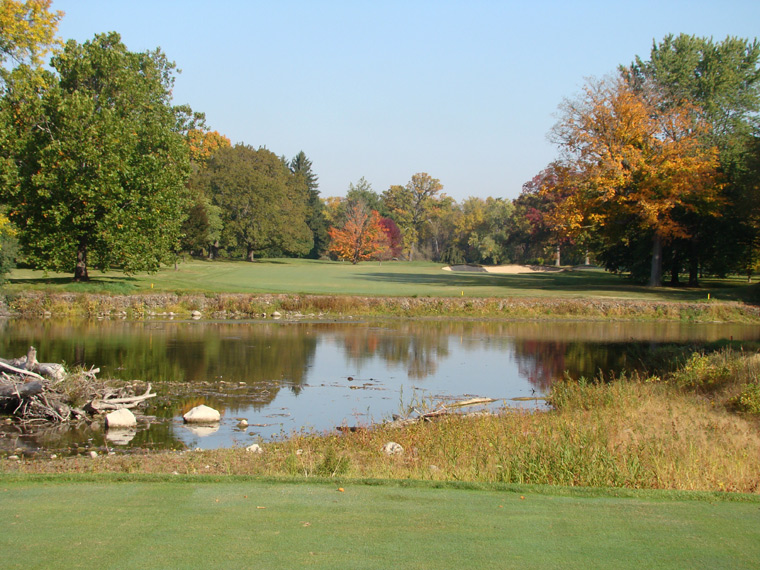
A successful tee shot across the Milwaukee River at the fourteenth hole sees the golfer leave the last plot of land that the club acquired for the sake of Alison’s work.
One sequelae of the short lived Travis course was that the members became adamant that the ninth green return near the clubhouse (the Travis out side finished 300 yards away and created a lot of teeth gnashing). By the mid 1920s, nines that returned to the clubhouse were viewed as desirable by most clubs. The number of rounds played around the country was continually rising and returning nines gave clubs better control over the play. While this desire by clubs certainly placed an additional burden on architects; it did not present a major hurdle here. How many properties naturally afford seventy plus yard wide corridors for the first, ninth, tenth, and eighteenth holes like Milwaukee? Not many.
Yet in all the world of golf, there may not be four better holes that start and conclude nines than at Milwaukee Country Club. Think about it. The first drops down into the river valley, the ninth plays heroically along high ground and was improved when Trent Jones moved the green to its current location in the 1970s; the tenth starts on the bluff and plunges down toward the river and the eighteenth stands as one of the best finishing holes anywhere.
Parkland courses in the United States generally pale in comparison to the grander forms of golf because the environment is less memorable than a links found along the sea and lacks the exhilaration found in playing across a wide expanse of heath land. However as we see below, the case here is different and the glories of Milwaukee’s golf unfold in their own unique way.
Holes to Note
Please note: The yardage below are from the 6,900 yard set of tees as few players need even consider the 7,100 yard set.
First hole, 435 yards; A rousing start! The golfer is given every opportunity to make a free flowing, positive swing from the elevated tee: all the hazards are clearly visible, the fairway is broad, and the trees are properly back from play. Yet, such was not the case a decade ago. Then, the golfer couldn’t even see the first green from the tee so much did the trees encroach from the right. Eight years ago, the board at Milwaukee had the good sense to contact Renaissance Design. Tom Doak and Don Placek came out to tour and since that time have worked hand in hand with the board and Green Keeper Pat Sisk to restore the scale and proportion of Alison’s work. The detail work carried out over the past decade is first rate. Note how the bunkers edge into the fairway. According to Placek, “We spent an awful lot of time making sure that the bunkers relate to the fairway and that the fairways relate to the bunkers.”
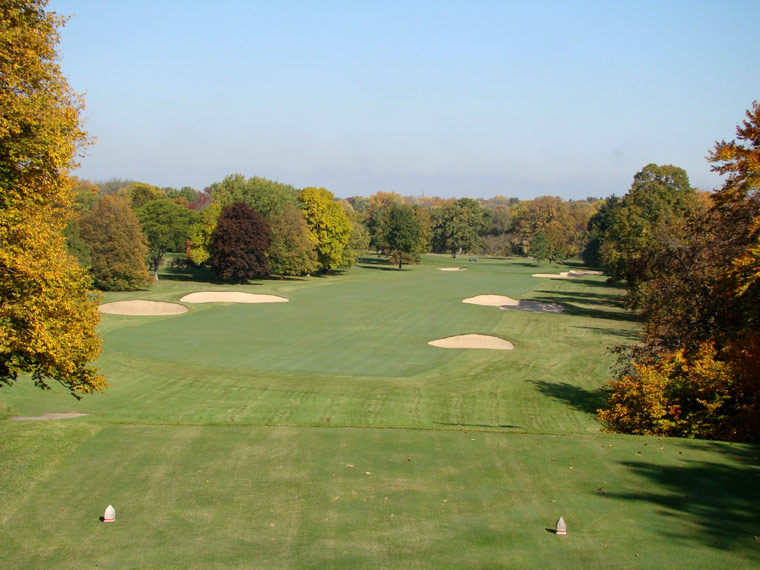
A good first hole should make a golfer itch to play and the first hole at Milwaukee does that better than most! It’s a special feeling to emerge from the Men’s Locker Room and stand on the first tee only a few paces later.
Fourth hole, 180 yards; Both the first and final one shotters play uphill at Milwaukee. That’s their only similarity though as this one sets up for a draw while the penultimate hole demands a fade. Given the shape of the green and the bunkering, the golfer wants the fourth to be a Redan, but he must put aside his instincts and accept this as a fine hole on its own. With the uphill nature of the hole (hardly conducive to a Redan), the green tilts from back to front but not so much from right to left.
Fifth hole, 435 yards; The recent widening of the neck of the fairway has restored the temptation on the tee as to whether to attempt to shape a draw with a driver or to lay back with a 3-wood. By removing a couple of trees and restoring Alison’s bunkers on the inside of the dogleg left, the same sense of spaciousness that pervades the rest of the course was returned to this hole. Up ahead, the pushed up green now features short grass around its banks – and there is nothing more that a good player fears than where short grass may ultimately deposit his ball.
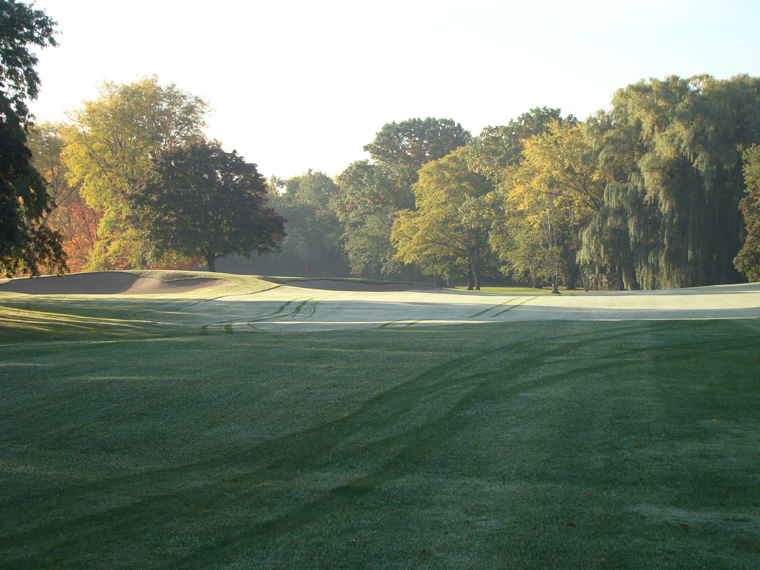
Once cramped, the fifth playing corridor has been opened up, returning Alison’s strategic options to the hole.
Sixth hole, 410 yards; Milwaukee possesses the full gamut of holes, from flat ones found in the river valley to its elevated interior holes where the topography lends playing interest. The sixth is of the latter variety and features the steepest uphill approach shot on the course.
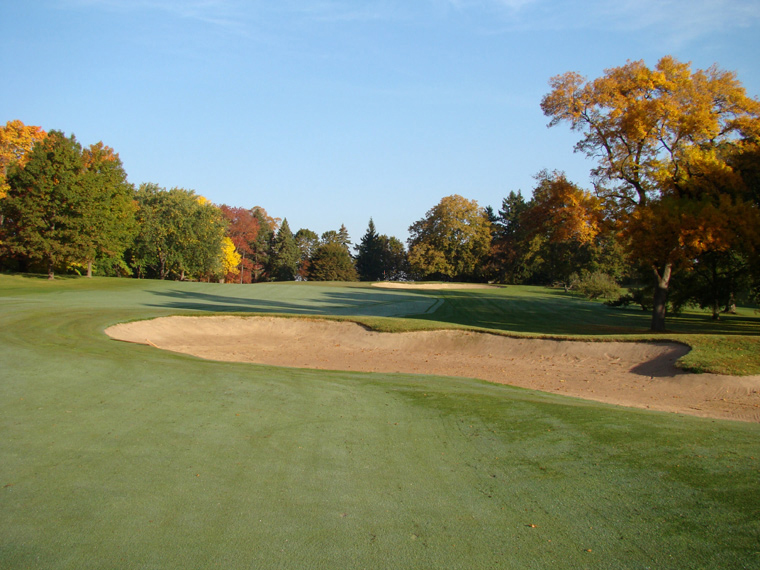
Unlike so many ill-presented parkland courses, the fairway bunkers at Milwaukee play bigger than their actual footprint with short grass feeding into them. Note the absence of thick rough to retard a tee ball from finding the fairway bunker at the sixth.
Seventh hole, 480 yards; Perfectly presented holes are always create a most pleasurable encounter. In this case, the hole looks to be straightaway and can play that way – but only for the courageous golfer. Here is a classic bunker configuration: hug the bunkers right off the tee and enjoy a good look into the green past the left greenside bunker. What makes the hole function perfectly is 1) the recaptured Alison tee on the left and 2) the mow lines whereby twenty yards of turf right of the green is maintained as fairway. Too many parkland courses feature thick rough encircling green after green, thereby giving the golfer the dull option of hacking out a pitch shot somewhere onto the putting surface. Far better and more engaging to allow the golfer to make a clean strike on the ball. Every time Renaissance suggested more short grass, Milwaukee eagerly agreed despite the additional economic requirements.
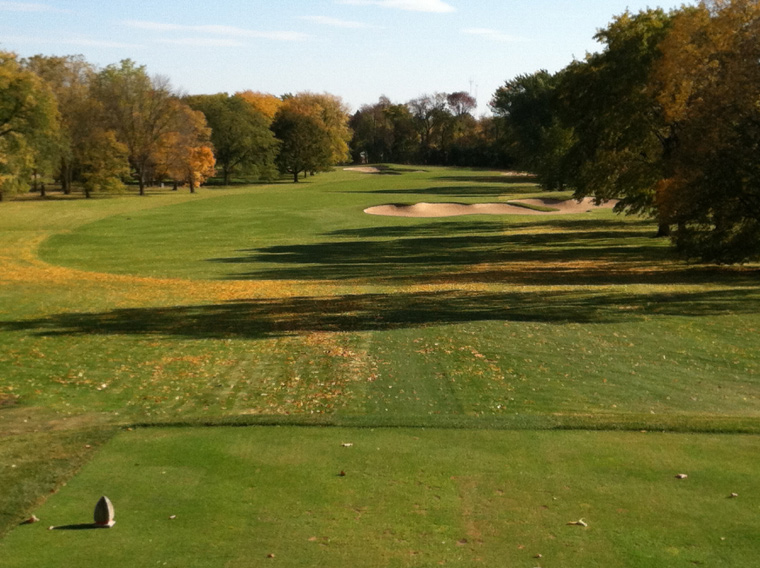
The courageous golfer takes the straightline down the hole by hugging the fairway bunker off the tee. Those less confident play to the left and then …

… to the right where there is plenty of short grass well right of the green. Few architects were better at adding strategic value by their placment of hazards than Alison.
Eighth hole, 175 yards; Most parkland courses suffer relative to other types of courses (links, cliffs, heath land, mountain) because their holes aren’t as distinctive. Here and over the next eight tee shots, Milwaukee serves up a dazzling and diverse array of shots that become seared into a player’s memory.
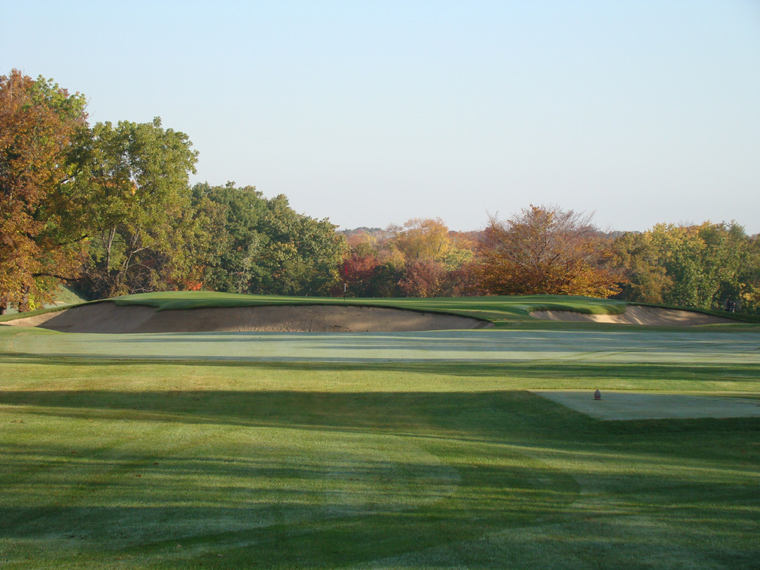
Where Alison procured the dirt to build some of his pushed up green pads is rarely evident. His work here and elsewhere around the world always sits softly upon the land.
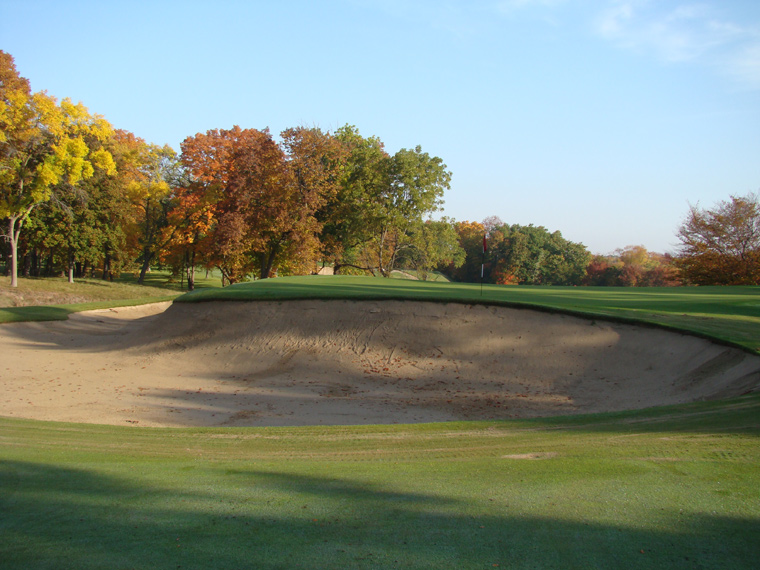
One thing’s for sure: Where there is a tall green pad, there are steep and deep greenside bunkers like those above. The golfer saves himself a lot of potential grief by hitting the green from the tee with what is one of the more important swings of the day.
Ninth hole, 325 yards; Played across the most rambunctious land on the course, the ninth is the favorite of many. And guess what? Robert Trent Jones Sr as opposed to Alison deserves the lion share of the credit. Yes, Alison’s hole emanated from here and played over much of the same fairway. However, in 1928, the clubhouse hadn’t taken its final form and Alison’s green was actually fifty yards left of today’s. Trent Jones moved it in the mid-1970s when he had the advantage of positioning it perfectly to the east wing of the clubhouse which serves as the handsome backdrop. Indeed, the feeling of occasion exists here so much so that one could be forgiven for thinking this is the Home hole.
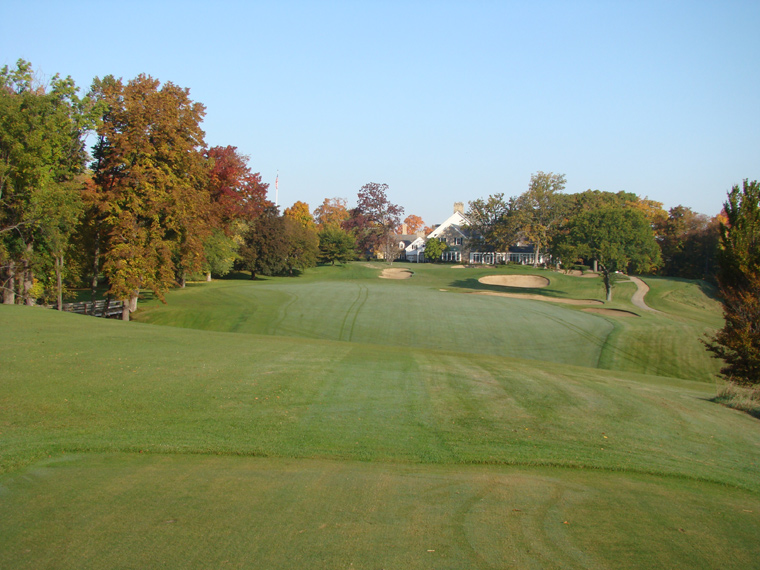
Alison’s green was fifty yards to the left of today’s location. Trent Jones moved it here in the mid 1970s. Though pure conjecture, one presumes that Alison would have done the same if the wing of the clubhouse had existed at his time.
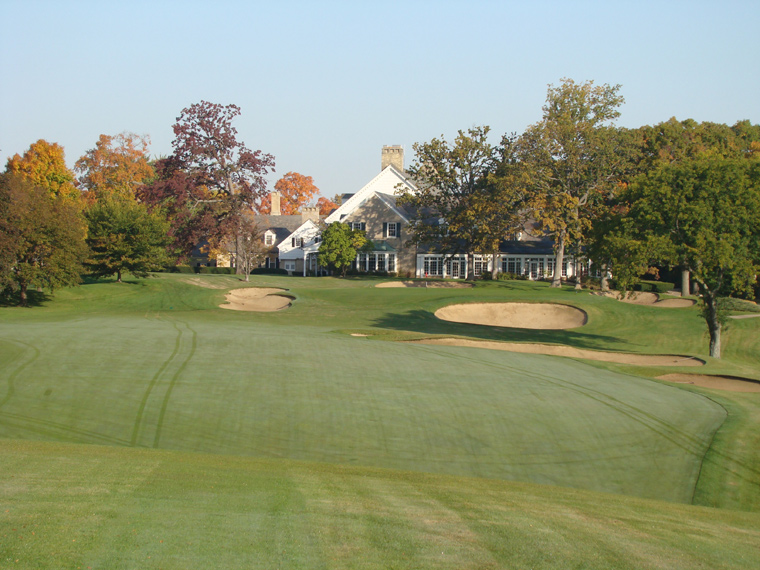
Calling for finesse, the pitch to forward hole locations at the ninth is one of the more nervy shots on the course. The agony of watching one’s approach land on the green, only to spin backwards and finish thirty yards down the hill is most demoralizing as the resulting thirty yard pitch might be even harder than the one from 100 yards!
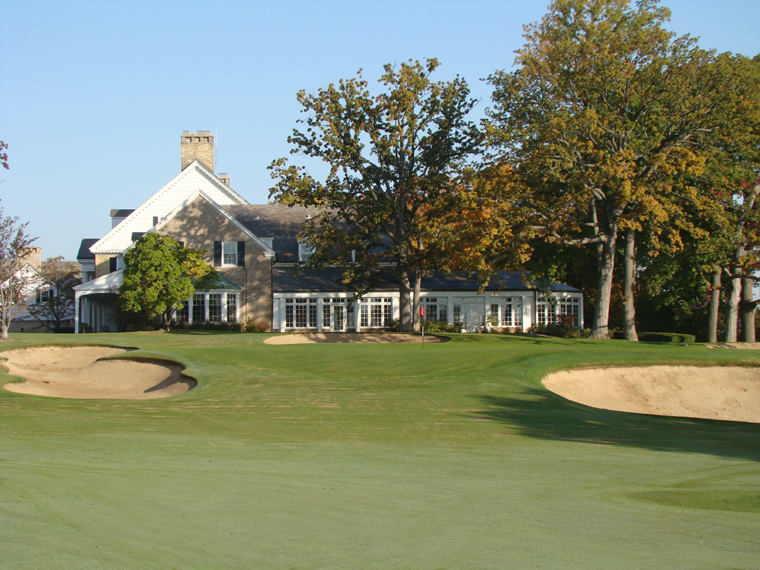
Trent Jones’s best work at Milwaukee mimics and compliments that of Alison. A good example is the false front of the ninth. Few golfers would suspect that different architects had built the false fronts at the ninth and eleventh greens.
Tenth hole, 485 yards; Surely a hole with such glorious natural attributes – a tee high on a bluff, the broad fairway in the river valley below, long views toward the bend in the Milwaukee River, and a green perfectly benched into the hillside – is guaranteed to stand the test of time? Not so, as the author can testify, A 1987 tour of the course showed something far different as a row of mature trees choked the hole from the right. Gone was the long view, gone was the width of the fairway and in their place was a one dimensional hole played through a narrow corridor of foliage. The transformation of the tenth from one of the weaker holes on the course to one its the best helps cement Milwaukee’s status as one of the two or three best courses in the Midwest.
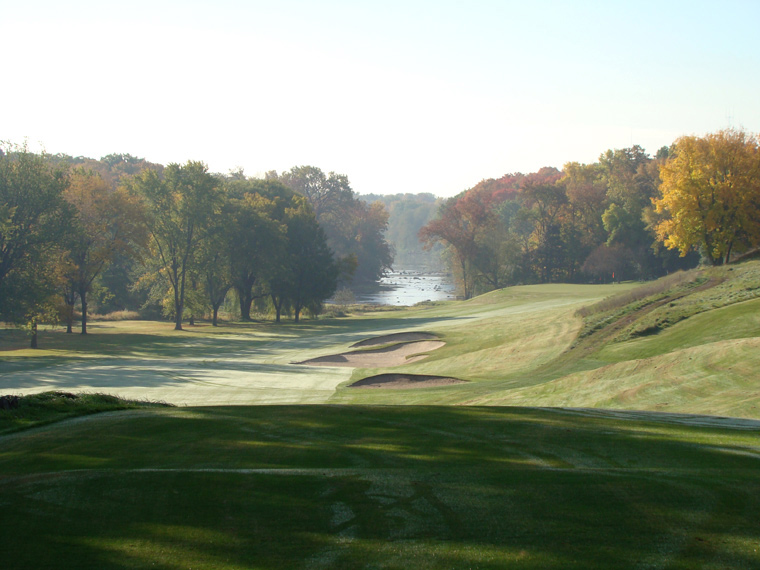
Congratulations to the board, Green Keeper Pat Sisk and Renaissance for restoring the full grandeur to the tenth hole. As Placek notes, “All golfers now get a true sense of the course’s amazing proximity to the river. This happens at precious few courses so it helps make a round at Milwaukee all the more special.”
Eleventh hole, 375 yards; The tee is attractively placed along the river bank and the hole itself bends left with the elbow of the Milwaukee River. Alison placed several bunkers on the inside of the dogleg and then Trent Jones added several more to give the hole its distinctive look. In many ways, the advances in technology have made this hole more interesting as the strong club golfer might opt to carry the field of bunkers under certain circumstances. While the range of playing lines off the tee varies by nearly 100 yards (!), the challenge at the green does not. Hit the back plateau or watch your ball being swept off the front of the green courtesy of Alison’s dramatic false front.
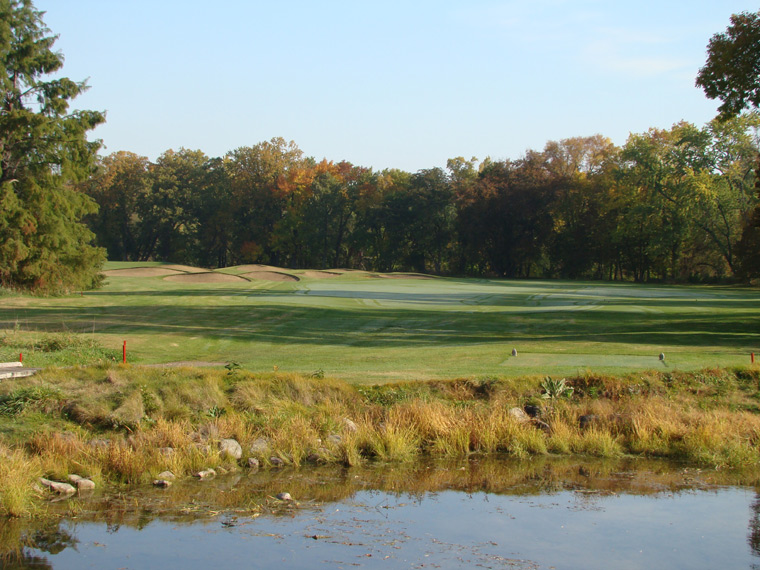
There is proximity to the river and then there’s the river itself, lapping up against the eleventh tee!
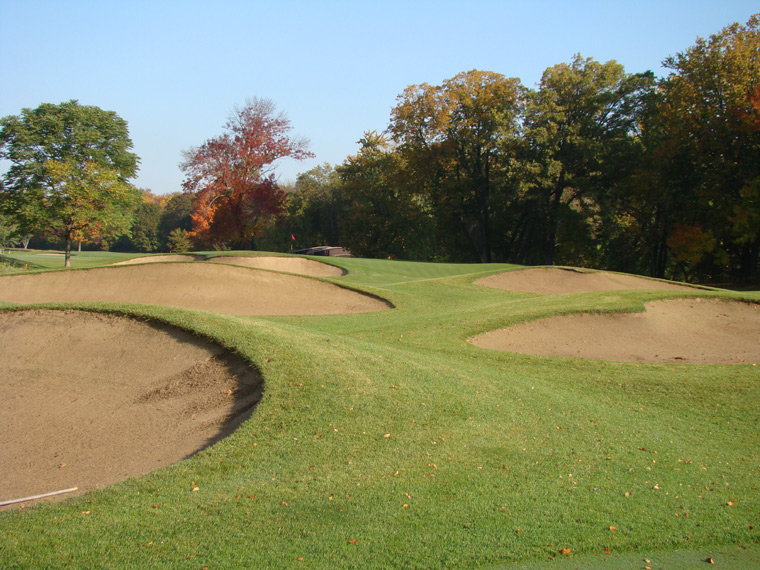
The eleventh fairway swings left around a nest of eight bunkers.

One of the game’s most dramatic false fronts is found at the eleventh at Milwaukee Country Club.
Twelfth hole, 180 yards; An obvious strength of Alison’s routing is found in how he used the Milwaukee River. He gradually introduces the golfer to it via long glimpses from the eighth, ninth and tenth holes. The river brushes up against the eleventh tee before peeling away from the line of play. Now standing on the twelfth tee, the golfer is directly confronted by the need to carry it. True, the mid iron shot was more terrifying in the days of hickory golf when the course opened in 1929 (steel shafts didn’t take over for another few years). Today, the green contours provide the bigger challenge.

Nothing too complicated but it’s man versus nature at a high level at the twelfth. The merits found amid the sound and solitude of play across a fast moving body of water can’t be overstated.
Thirteenth hole, 390 yards; The perfect foil to the dogleg left eleventh, it swings to the right around a large flat bunker complex. As flat as flat can be, man’s hand was required to give this hole its golf qualities which is what Trent Jones did when expanded upon Alison’s bunker scheme. Greenside, the distinctive left and right bunkers with their high sand faces define the target and provoke concern. To cap it off, Renaissance and Sisk worked hard to remove the vegetation and bracken behind the thirteenth green to restore the clean lines that existed in Alison’s day.
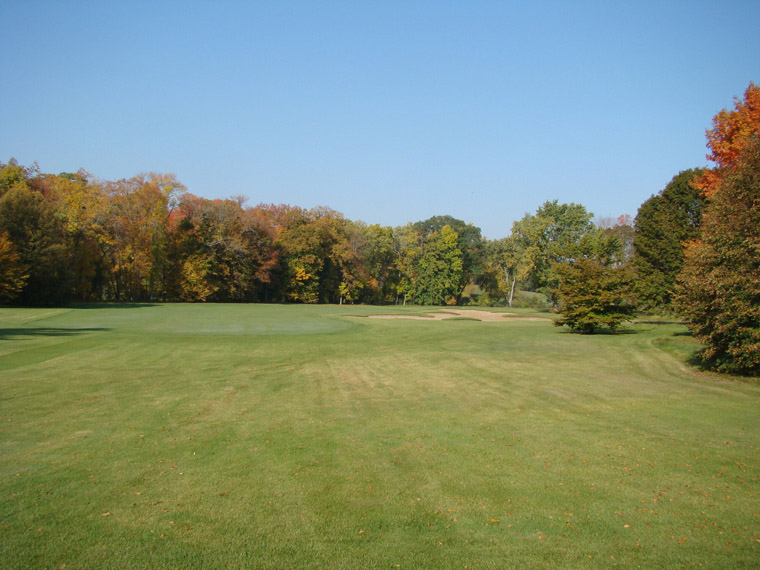
When nature took a break, man needed to step in and that’s what happened …

… when Jones expanded upon Alison’s bunkering scheme on the inside of the dogleg. When asked why much of Jones’s work at Milwaukee seems to compliment Alison’s so well, Placek notes that Jones shared Alison’s penchant for big boned courses that featured lots of exposed sand.

Note the impressive, near vertical face at the left greenside bunker. Sisk says, “We prepare all our steep faced bunkers in a similar manner with bunker faces only “smoothed” when needed. This allows the sand to set up as firm as possible to minimize washouts during ordinary rain events and minimize the chance of a buried lie in the face. On occasion we will use a “Sand-Pro” machine to fluff up the bunker floors. We take great steps to avoid the toe of the bunker face slopes in order to protect the stability and integrity of this stabilizing bond. If additional sand is ever needed in a bunker we ONLY add it to the floor. Old and contaminated sand packs quite well and serves a great purpose on the faces. Some new sand does find it’s way onto the face however and this migration helps to keep a uniformed color appearance throughout the surface.”
Fifteenth hole, 585 yards; The start of a difficult closing stretch, this hole has been the beneficiary of various changes over its eighty year life span. First, Sisk cleared a densely wooded area directly behind the fourteenth green in 2007, making room for tees that stretch the hole into a true three shotter at 585 yards. Up ahead, Trent Jones saw fit in the 1970s to extend a string of Alison bunkers farther into the fairway, creating a Sahara type hazard. Sixty yards short of the green is a bunker with a rolling sand face exquisitely restored by Renaissance’s Brian Schneider to nothing short of a work of art. The green itself is a rarity in that the right half dates back to Robertson’s 1911 course. Both Travis and Alison thought highly enough of it to leave it alone (Jones expanded it left toward the sixteenth tee). The end result of the various stages of this hole’s evolution? Each shot is of great interest, a rarity among par five holes these days.
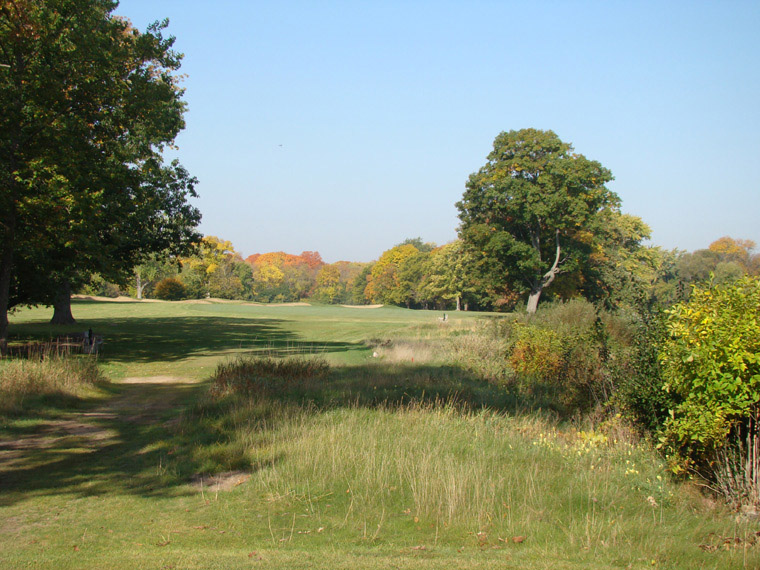
Alison never worked in the area where the new back markers are for fifteen. He didn’t need to as his hole was plenty long for hickory shafts. The creation of this back tee makes the hole play once again as the true three shotter that Alison intended. Though out of this photograph, the broad Milwaukee River is a scant twenty yard to the right.
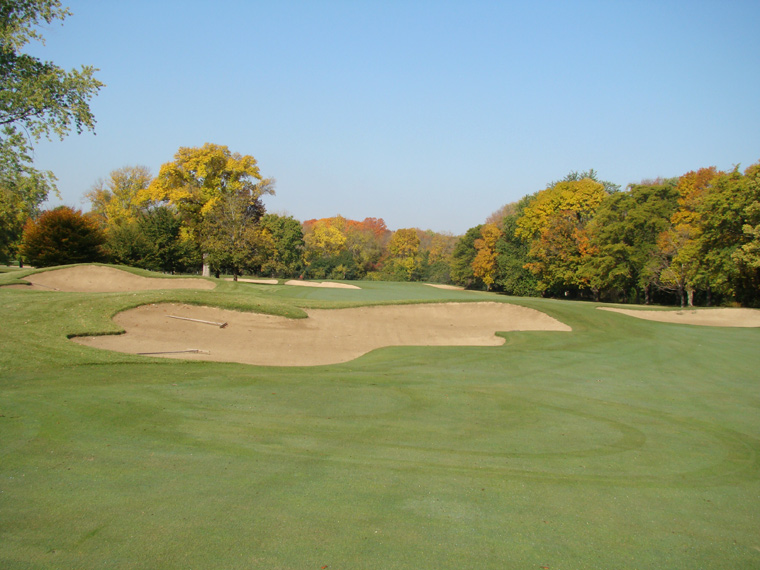
Cross hazards such as these that need to be crossed with one’s second shot and this one …
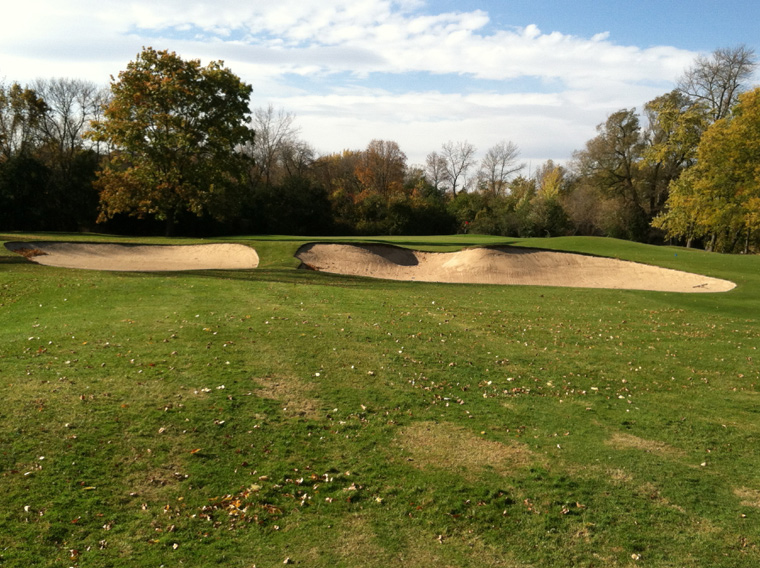
… found sixty yards short of the green. Note the artful manner in which Brain Schneider restored the curved bunker walls. Sisk notes that “We spend nearly 3X more man hours in bunkers than we do on putting greens! The good news, for me, in this investment is that MCC has some spectacular pieces of art and engineering in our bunkers. Ultimately the time and money spent protecting these pieces are well worth the investment as our members are deeply appreciative of this aspect of the course.”
Sixteenth hole, 450 yards; One of Placek’s favorite quotes from Colt & Alison’s book,,Some Essays on Golf-Course Architecture is the following: On inland courses which are not heather country it is desirable that fairways should be mown to as great a breadth as funds will allow, and that artificial sand-bunkers should be utilized wherever side-hazards are required. If it is done it will prevent a large number of balls from being lost and thus save much exasperating delay, and it will provide for the inaccurate player a much more interesting form of recovery stroke. Another quote from the same book that applies well to the sixteenth at Milwaukee is in regards to the entrance of greens and reads: The entrance of the green, that is to say the portion of the fairway free from hazards on which the approach should pitch, should be an object of considerable care in construction…Whether the approach shot be good, bad, or indifferent, it should receive the treatment which it deserves and should obtain the amount of run which its trajectory and spin indicate. The sixteenth embodies these virtues. Given that it is largely a ground game hole, it also highlights the perfect fast and firm playing conditions that Sisk provides on a regular basis.
Seventeenth hole, 195 yards; Few architects excel at routing eighteen holes and this was Walter Travis’s undoing at Milwaukee. Alison is one of the twenty or so architects of all time that could successfully string one hole after another and have all eighteen holes be of a uniformly high standard. Take the final two holes as case in point. Having just played the last 6½ holes in the river valley, Alison needed a way to transport the golfer back to the clubhouse on the bluff. He accomplishes the task admirably, starting with this brutish uphill one shotter. Alison succeeded in part by following his own advice in Some Essays where Colt and he wrote, “It is far easier and cheaper to cut artificial bunkers on the face of a natural slope or hill than it is to construct them on flat ground. It is easy to give such bunkers an impressive and awe-inspiring appearance, and there is far less soil to shift.” The pit right of the seventeenth green is a perfect example. The expanse of fairway left of the green aids in the hole’s grand scale. In fact, the hole plays quite reasonably from its back marker of 235 yards.
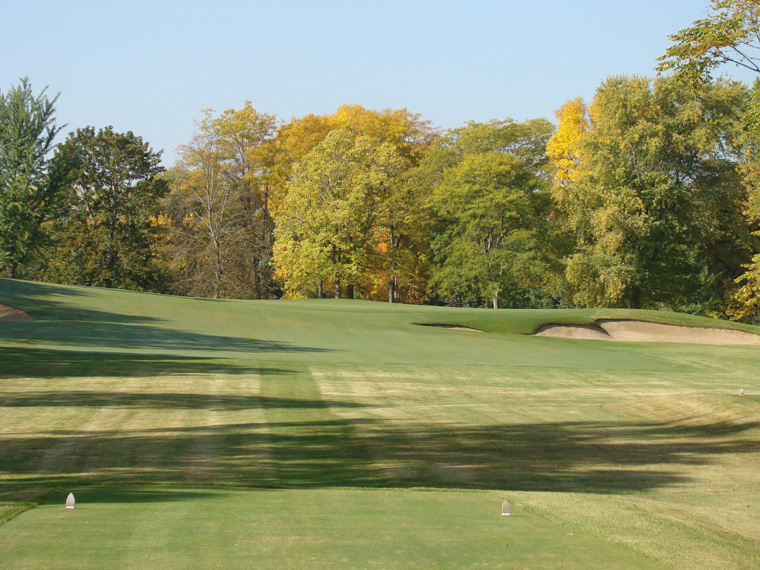
The left to right kick bank enables golfers of all skill levels a chance. Tee balls missed into the deep right greenside bunker guarantee a recovery shot to a putting surface that is out of view.
Eighteenth hole, 425 yards;What makes a great closing hole? Name a qualification and this hole possesses it. Is there a premium placed on execution? Absolutely, the tee ball needs to be well struck for the golfer to reach the crest of the hill and have a good view of the green with a reasonable club in his hands. The approach shot is demanding too as the putting surface has the most interior contour on the course. Is there a sense of moment? Definitely, from the crest of the hill the golfer has his first view of the handsome clubhouse since the turn. The green is tucked into its own amphitheatre, framed by large maples and lots of short tight, bent grass that feeds unnervingly toward the clubhouse behind. Combine all these elements and you have the finest finishing hole in the Midwest. Play here and the penultimate hole helped to shape the American victory in the 1969 Walker Cup.

Great architects exploit landforms in every manner possible. Alison’s decision to drape the eighteenth fairway up and over a ridge line was genius and provided the hole with its enduring playing characteristics. It’s the only dramatically uphill tee shot on the course and it nicely balances the downhill ones found at the first and tenth.
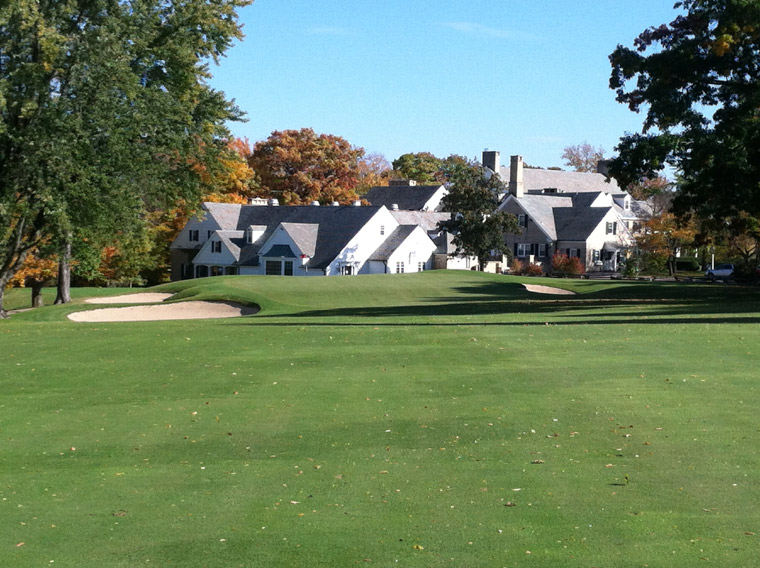
What a rarity! Here’s a downhill approach to a Home green with a clubhouse in the background that lords over the property from every other vantage point. Where there is an elevated clubhouse there is generally either a uphill slog of a closer (Jupiter Hills, Colorado GC) or a long walk in like at Shinnecock. By virtue of the clubhouse relocation 250 yards to the north and somewhat downhill in 1928, the final approach is played from the high spot of the property, once occupied by the old clubhouse.
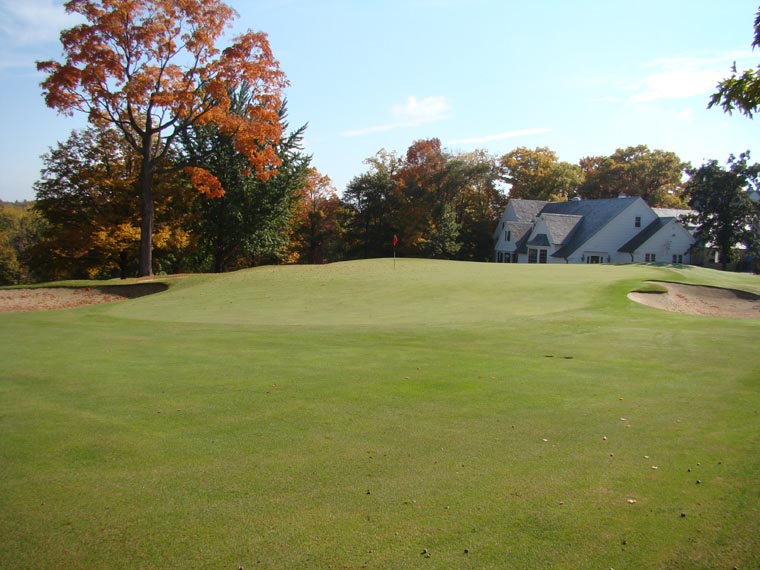
The fiendish contours found with the putting surface of the Home green ruthlessly expose frayed nerves.
Dissecting the weaknesses of a course is always fun. Some are irreparable like poor property and/or poor routing (i.e. what Milwaukee suffered through in its first 30 years of existence). Some designs suffer because they are not fun to play, be it from a lack of strategy or a lack of interesting features or both. Some courses and their holes blur together in one’s mind on account of their sameness and lack of character. Others are doomed by poor turf quality. All such flaws are absent at Milwaukee Country Club.
Alison did his part by spending the needed time to ensure that a great course emerged from a great landscape. In master architect Alison, you have a man who at one point or another was responsible for nearly 10% of the courses that would be considered world top 100. Recent boards at Milwaukee have brought to bear the right confluence of talent to ensure that this Golden Age design is displayed at its peak. As such, Milwaukee Country Club once again is among the world’s elite courses.
When Colt and Alison penned Some Essays in 1920, they praised seaside golf while noting the potential shortcomings of an inland course. They opined, “When the golfer has left a grimy city for a few hours’ relaxation he wishes to find rest and pleasure in the scenery of the country but it often happens that such a place does not do all that it should to provide him with what it requires.’ They wrote those words some seven years before Alison arrived at Milwaukee. Though prescient and accurate for many inland courses they happily don’t apply at Milwaukee where Alison’s work scores high marks by any measure that matters.
The End

